Scientific Background Information
Addressing academic discourse is an essential preparatory part for the development of a research project, allowing the identification of the current state of the scientific agenda, the identification of gaps in existing knowledge and the adjustment of the project vector so that the work as a whole has a significant contribution to valuable knowledge on the topic. This critical literature review proposes to assess the problem of autonomous craft as a promising part of the coming future, namely identifying opportunities, strengths, and weaknesses as well as potential barriers and challenges that the industry may face.
The motivation for choosing such a topic stems from the growing interest in process automation observed in all fields, as well as the increasing importance of maritime shipping as one of the main economic instruments of the modern world (Enríquez et al., 2020). The following sections are devoted to a review of the available evidence, divided into separate sections according to the attribute of the problem under study.
Conceptualizing the Term
Primary to the study of the state of academic storytelling is the conceptualization of the term autonomous ships as an actual variable of interest. In the market report, Wood (2022) stated that autonomous ships should be referred to as ships without a crew to manage operational processes. She reports that “the autonomous ships are equipped with advanced technologies, including artificial intelligence, cloud computing, the internet of things, and others, to control their operations” (Wood, 2022, para. 4).
Wariishi (2019) points out that the academic community’s increased interest in the idea of autonomous ships stems from their ability to address the current challenges of the shipping industry in improving employee working conditions and preventing maritime accidents. Agreement between Wood (2022) and Wariishi (2019) is reached on the classification of the autonomy of such vessels: formally, they can be divided into semi-autonomous and fully autonomous. Figure 1 shows the more detailed classification proposed by Wariishi (2019), depending on what level of autonomy exists on the vessel.
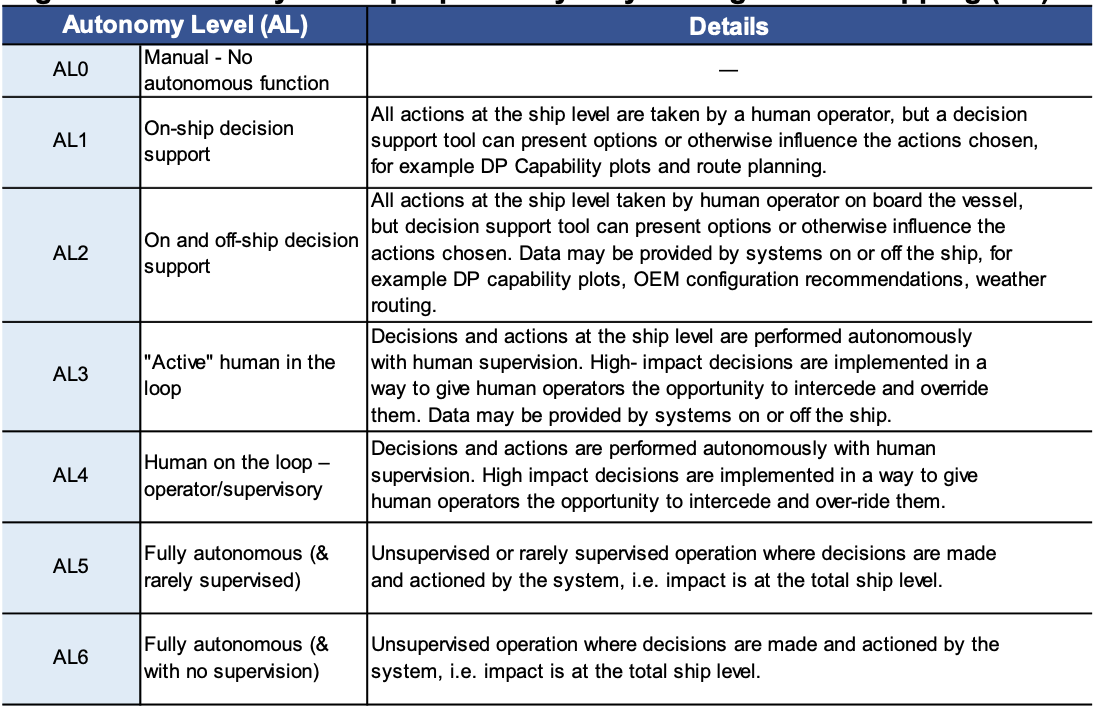
In the academic field, the phenomenon of autonomous ships is closely associated with the advent of the fourth industrial revolution, characterized by high rates of automation and optimization of routine processes.
In their study investigating the educational aspects of autonomous ships to educate highly skilled industry professionals, Belev et al. (2021) report that “the idea of creating and implementing autonomous ships is cited as a lifeline to overcome the shortcomings that disturb the industry due to the human factor” (p. 388). Thus, from a synthesis of three different approaches to conceptualizing the term, it can be postulated that autonomous ships should be defined as ships where most operational processes are not controlled by a crew or dispatcher on land, with highly integrated technological equipment and artificial intelligence, whose development aims to address the current challenges of human error, economic and logistical risks, and collisions and shipwrecks.
The Needs for Autonomous Ships
In determining the importance of the phenomenon of autonomous ships, it is essential to clearly justify the causal base that motivates researchers and engineers to invest in building such machines. Conventionally, the set of such reasons can be divided into those related to human activity and those not. The first category of factors should primarily include the problem of human error: as a result of faulty actions by responsible individuals, wrong decisions or negligence, a ship can face serious problems, up to and including shipwreck (Ramos et al., 2018; Ahvenjärvi, 2016). Researchers recognize that human error should not be perceived as an individual characteristic of a particular individual but instead should be seen as some aggregate, impersonal factor that statistically affects the ship’s steering efficiency (Ahvenjärvi, 2016). Such errors are not limited to making poor decisions on board during a voyage but also include design and testing miscalculations and inaccuracies in maintenance and verification procedures.
It is accepted that autonomous ships will be able to solve most of the human error problem, as the primary management of operational processes is the responsibility of computerized systems, which cannot get tired or have professional burnout, but do the job with the data they possess (Ramos et al., 2018). In this context, it is fair to recognize that the human factor problem will not be wholly eliminated with the widespread introduction of autonomous ships for two reasons. First, the design and testing of such systems will still be part of human responsibility, and even minimizing human involvement will not eliminate the likelihood of errors. Second, the widespread market adoption of autonomous ships in the short to medium term will not eliminate the use of human-controlled vessels, and thus the single maritime space will be shared by both types of ships, which still maintains the possibility of a shipwreck (Ramos et al., 2018).
This problem, found in some academic sources, is being addressed by others: in particular, Rødseth, Wennersberg and Nordahl (2021) reported that at the beginning of the mass uptake of autonomous ships, it is crucial to have human operators on board who can make decisions in critical interaction situations with classical ships, and in the long term, technologies for improved data exchange between ships will be an effective solution. Thus, while autonomous ships have at their core the desire to minimize the problem of human error, they do not solve it completely, at least in the medium term.
Related to human activity on board is the safety of the crew, passengers, and cargo resulting from human error. Statistics (see Figure 2) show that the number of shipwrecks does not follow an orderly trend and changes dynamically between years. Thus, as of 2020, the number of shipwrecks was six percent higher than in 2019, and the main types of vessels that suffered accidents were fishing and heavy-lift vessels (see Figure 3) (TSB, 2020). These data are also confirmed by SRD (2022a), according to which, between 2011 and 2021, the most significant proportion of losses were among the cargo, fishing, and passenger ships (Figure 4).
Interestingly, according to the Transportation Safety Board of Canada, the most frequent causes of shipwrecks were collisions, grounding, and fires on board (TSB, 2020). However, an independent study shows that in the same period, the leading cause of shipwrecks was waterboarding due to faulty design or ineffective ship management (de Vos, Hekkenberg and Banda, 2021). Regardless of the factor that led to the accident, it is evident that the safety and health hazards to the crew and passengers caused by shipwrecks are significant. According to data describing mortality trends for the US, it is known that more than 3,200 people have been injured or died as a result of ship accidents, and it is essential that this figure does not have a steady downward trend (SRD, 2022b).
Thus, the issue of the safety of people on board is a critical and urgent one, and with the expansion of the shipbuilding industry, one would expect trends in injuries, deaths, and shipwrecks to show an upward trend.

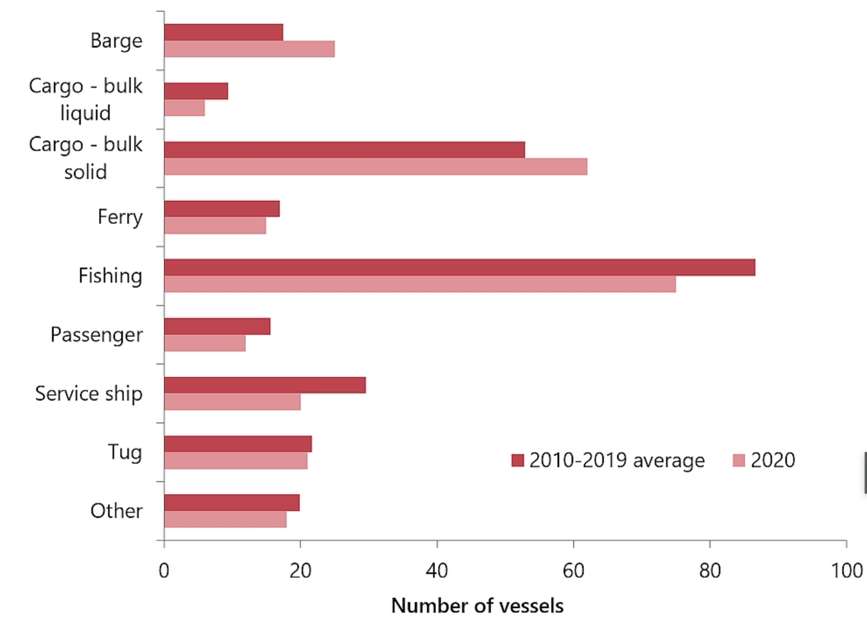
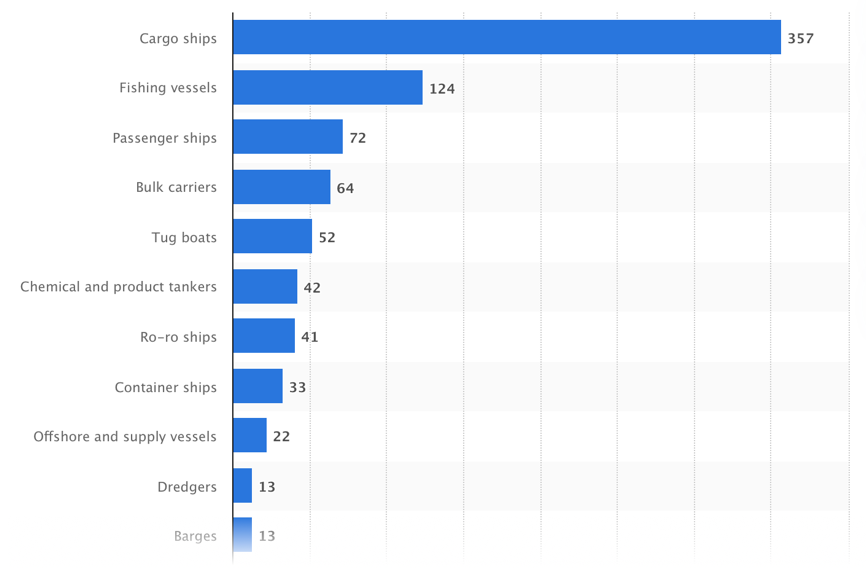
The answer to this safety problem is the use of autonomous ships, which will reduce the number of shipwrecks. One of the main factors for this reduction is the physical reduction in the number of people on the high seas (de Vos et al., 2021). Statistical analysis has shown that the introduction of autonomous ships, especially cargo ships up to 120 m in length, will save up to 69.5% of crew lives, which can be seen as a tangible contribution to improved safety. The same analysis in a scenario where absolutely all ships at sea become autonomous showed that in this case, all seafarers’ lives could be saved, and there would be a reduction of 174 deaths per year on the high seas due to shipwrecks (de Vos et al., 2021).
A study based on a systematic review demonstrated that the main advantage of autonomous ships to improve safety is a systems approach, a focus on safety culture, and a review of existing policies to make relevant changes (Abdelraouf and Elsayad, 2020). Among others, safety is achieved through the integrated use of as much data as possible, including satellite navigation, as shown in Figure 5 (Höyhtyä and Martio, 2020). Thus, the problem of safety on board can be solved through the introduction of autonomous ships, but this solution must be approached in a comprehensive and systematic manner.
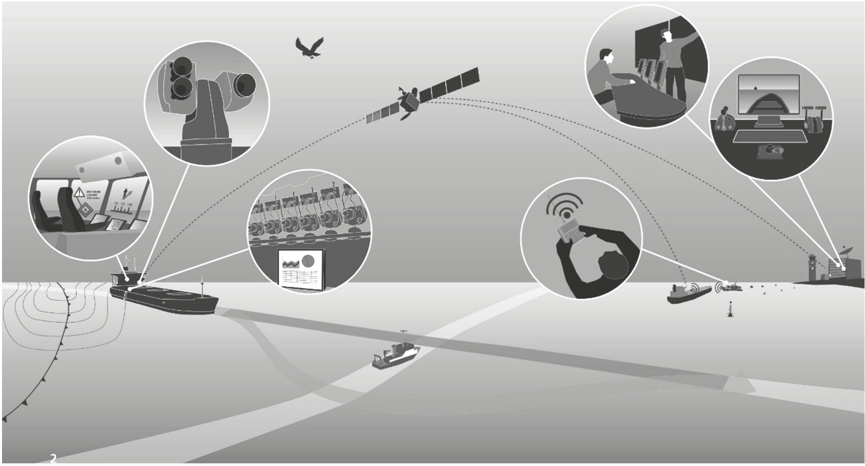
The second category of reasons for the mass implementation of autonomous ships should include factors not directly related to human activity. Such advantages include economic, environmental, and interoperability factors (Kurt & Aymelek, 2022). In terms of economic factors, studies show that the use of autonomous ships will result in lower operational costs and employee payroll (Wasilewski et al., 2021). Wasilewski et al. (2021) do not offer specific estimates of this benefit, but calculations can be found in Kretschmann, Burmeister and Jahn (2017). In particular, the authors showed that the freight rate for cargo would be lower by 3.4% for an autonomous vessel compared to a classic vessel. Other calculations show savings in operating costs of up to 20% (Wood, 2020).
A more significant impact, though not quantified in the works, is the global effect of such ships on logistics systems. According to Tsvetkova and Hellström (2022), “autonomous shipping has a greater potential than simply replacing humans with machines. Rather, autonomous ships can play a role in transforming logistics and supply chains” (p. 274).
The authors elaborate on this thesis by pointing out that one should expect a radical change in the roles of key stakeholders — suppliers, ship owners, operators — changes in the business models for managing such ships, a steady conquest of the market niche, and the creation of a new digital economic ecosystem. Particularly dangerous in this context is the perceived reduction in the number of jobs, which is a global concern with regard to the automation of routine processes. For example, according to a survey, up to 80 per cent of professional seafarers are concerned that they may lose their jobs because their robotic processes have been displaced (Uniteam Marine, 2022). Thus, the economic impact of autonomous ships is high, but quantitative scientific data on exactly how the introduction of autonomous ships will affect the economic component of the project is scarce, as revealed by a source search.
An essential feature of autonomous ships is their ability to conserve fuel, optimise internal processes and significantly reduce human error, thus creating positive opportunities for environmental safety. Careful calculations have demonstrated that there are significant environmental benefits for all types of autonomous ships, particularly for short-range ships (see Figure 6). In addition, it should be considered that the risks of oil spills and marine pollution are lower due to the lower probability of collision and sinking of an autonomous ship (de Vos et al., 2021; Abdelraouf and Elsayad, 2020).
Additionally, it is pointed out that the widespread proliferation of autonomous ships will necessitate a review of current institutional policies, particularly in the area of environmental monitoring, as such ships without people on them may be vulnerable to terrorist and pirate groups (Kim et al., 2020). As a consequence, the environmental benefits of autonomous ships are tangible, but like the economic component, they need to be sufficiently elaborated in academic discourse.
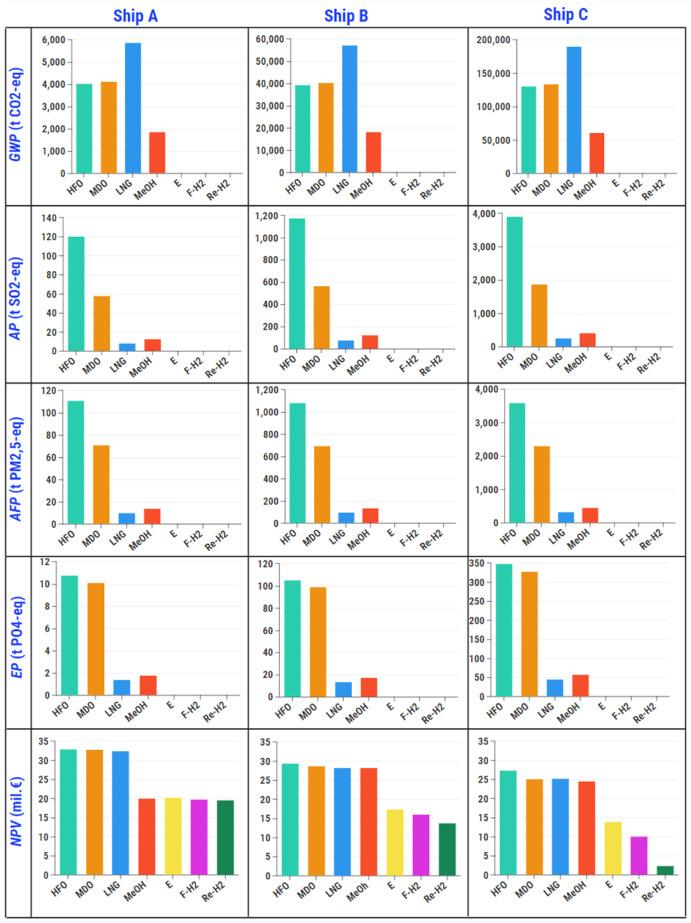
Perceived Risks
Along with the perceived benefits of introducing autonomous ships, the risks that can lead to a reduction in the overall effectiveness of these strategies should be carefully considered. As with any digital technology, control systems in autonomous ships are vulnerable to cyberattacks, and thus there is an urgent need to develop defence systems (Kim et al., 2020; Tusher et al., 2022). Cybercrimes against autonomous ships prove critical, especially when transporting valuable cargo, be it human lives, oil, or precious commodities. Not only can mastering the ship’s controls be the target of hacking attacks, but also an attempt to learn sensitive shipping information, including addresses and customer names. In addition, a classic risk is equipment malfunction, which in the absence of people on board, cannot be resolved promptly (Chou, Wang and Hsu, 2022; Utne et al., 2020).
Thus, if the ship goes astray and poses a threat to public safety, remote control by the dispatcher may be highly ineffective, posing a serious problem. Since an autonomous ship is assumed to be self-driving, route recognition errors cannot be ruled out. There are already multiple known cases where autopilot functions prove to be harmful and dangerous, and in the context of a multi-ton vessel, this can be a serious threat (Usach, Vila and Gallego, 2020; Cuéllar, 2019). In the context of stormy weather and loss of radio signal, information about the route of such a ship, as well as the correctness of the route programme, may be scarce and distorted, which also poses economic and safety risks.
Legal Issues
When deciding on mass production and deployment of autonomous ships, one of the cornerstone issues is the legal field and jurisdiction of individual states. To date, the academic community has yet to offer many studies and case studies, as autonomous ships are exceptional and primarily experimental developments; however, some evidence does exist. Research shows that IMO regulations do not currently include widths for implementation in the practice of autonomous ships, so they should be reviewed and supplemented (Kim et al., 2020; Ringbom, 2019). Vojković and Milenković (2020) recognise that current technological advances are significantly ahead of the current legal framework, which supports the need for a thorough review of policies. One of the most critical issues is determining who is the ship’s captain and key decision maker when there are no people on board the ship (Vojković and Milenković, 2020).
The potential inapplicability of the Hague Rules, indicating the responsibility of the parties in the case of classical shipping, also causes a change in classical functional roles (Carey, 2017). Including as Wilhelmsen and Bull (2020) recognise, difficulty arises with insurance systems as well, as insurance companies may not take on the risks to manage experimental technologies. As a consequence, in the absence of fundamental changes to the current legal framework, autonomous ships have the risk of being unclaimed and dysfunctional, as they will not be able to move freely, moor in ports and have guaranteed protection in national waters.
Project Methodology Plan
Rationale
An extensive literature review demonstrated that most of the research is prospective and predictive, describing significant advantages of autonomous ships for the medium-term future and demonstrating the impossibility of mass deployment at present. One of the conclusions of the literature review is the multiplicity of different considerations for autonomous shipping, which nevertheless leads to a need for more highly specialised results. At the same time, a deficit in the measurement of economic and environmental benefits was demonstrated. Based on the problem found, the topic of the research project “Are Autonomous Ships the Right Approach for the Future?” seems to be a helpful addition that contributes significantly to the academic discourse on the topic.
Methodology
The methodological underpinning for the project is a quantitative paradigm focused on capturing the current perception of critical trends and issues in autonomous shipping. The development of a questionnaire to collect and analyse the views of the various stakeholder cohorts is a crucial tool to cover the identified deficits. Specifically, a single survey based on a five-point Likert consent scale will be conducted among several groups of respondents based on their professional backgrounds: seafarers, cybersecurity professionals, lawyers, environmental security professionals and insurance agents. The survey data will be collected, followed by descriptive and inferential statistical analyses, including a one-way ANOVA. ANOVA is a statistical test to test for and detect differences in mean values between groups, indicated by the level of the p-value compared to the critical level of significance alpha (.05) (SL, 2021). The results should reveal the key risks and concerns that professionals currently have for the idea of widespread autonomous craft in the near future.
Research Hypotheses
Based on the preferred statistical tests and given the overall goal of the project, the following hypotheses apply to the work:
- The null hypothesis (#1): according to the results of the agreement assessment (question 8), there are no significant differences between the professional groups. Alternative hypothesis (#1): according to the results of the consent assessment (question 8), there are significant differences between the occupational groups.
- The null hypothesis (#2): according to the results of the priority assessment (question 9), there are no significant differences between occupational groups. Alternative hypothesis (#2): according to the results of the prioritisation assessment (question 9), there are significant differences between occupational groups.
- The null hypothesis (#3): according to the results of the prioritisation assessment (question 9), there are no significant differences between the geographic groups. Alternative hypothesis (#3): according to the results of the priority assessment (question 9), there are significant differences between the geographic groups.
- The null hypothesis (#4): according to the results of the agreement assessment (question 8), there are no significant differences between the geographic groups. Alternative hypothesis (#4): according to the results of the agreement assessment (question 8), there are significant differences between the geographic groups.
Variables
The independent variables for this project are respondents’ occupational and geographical backgrounds, as it is expected that changes in these attributes may lead to differences in the results. The dependent variable measured on five-point Likert scales — questions 8 and 9 — will be the degree of agreement and priority in respondents’ answers, namely the mean values for which significance in differences is determined using statistical tests.
Resources Required
The following resources and materials should be used to conduct the project:
- An online survey distributed to respondents;
- Ethical endorsement from the University;
- Informed consent to be completed by participants before the survey;
- SPSS v.28 for statistical analysis;
- MS Word for writing the research report.
Time Management
Because the project requires significant time and resources, it is critical to plan all stages of the work and regularly checks that the progress being made is in line with the plan. Figure 7 shows a Gantt chart describing all phases of the overall project and their durations.
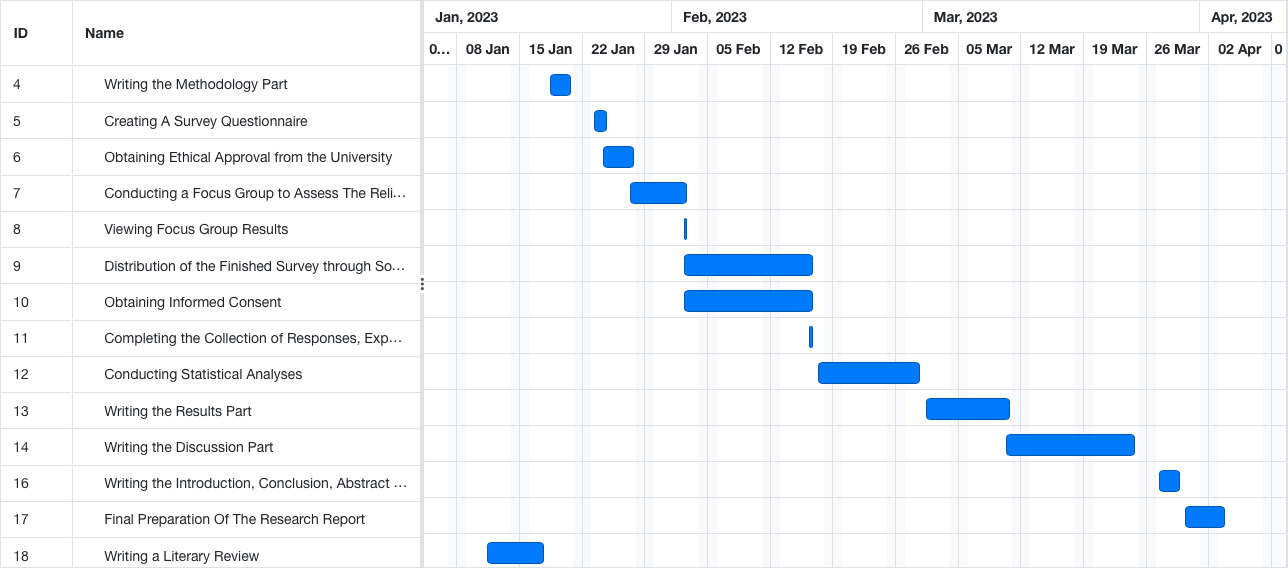
Reference List
Abdelraouf, E.E.Y. and Elsayad, H. (2020) ‘Implementing the safety culture improves the autonomous ships prosperity’, Journal of Shipping and Ocean Engineering, 10, pp. 5-12.
Ahvenjärvi, S. (2016) ‘The human element and autonomous ships’, TransNav: International Journal on Marine Navigation and Safety of Sea Transportation, 10(3), pp. 517-521.
Belev, B., et al. (2021) ‘Autonomous ships in maritime education model course 7.01’, Pomorstvo, 35(2), pp. 388-394.
Carey, L. (2017) All hands off deck? The legal barriers to autonomous ships. Web.
Chou, C.C., Wang, C.N. and Hsu, H.P. (2022) ‘A novel quantitative and qualitative model for forecasting the navigational risks of maritime autonomous surface ships’, Ocean Engineering, 248, pp. 1-16.
Cuéllar, M.F. (2019) ‘A common law for the age of artificial intelligence’, Columbia Law Review, 119(7), pp. 1773-1792.
de Vos, J., Hekkenberg, R.G. and Banda, O.A.V. (2021) ‘The impact of autonomous ships on safety at sea – a statistical analysis’, Reliability Engineering & System Safety, 210, pp. 1-13.
Enríquez, J.G., et al. (2020) ‘Robotic process automation: a scientific and industrial systematic mapping study’, IEEE Access, 8, pp. 39113-39129.
Höyhtyä, M. and Martio, J. (2020) ‘Integrated satellite–terrestrial connectivity for autonomous ships: survey and future research directions’, Remote Sensing, 12(15), pp. 1-24.
Jovanović, I., et al. (2022) ‘The feasibility of autonomous low-emission ro-ro passenger shipping in the Adriatic Sea’, Ocean Engineering, 247, pp. 1-12.
Kim, M., et al. (2020) ‘Autonomous shipping and its impact on regulations, technologies, and industries’, Journal of International Maritime Safety, Environmental Affairs, and Shipping, 4(2), pp.17-25.
Kretschmann, L., Burmeister, H.C. and Jahn, C. (2017) ‘Analyzing the economic benefit of unmanned autonomous ships: an exploratory cost-comparison between an autonomous and a conventional bulk carrier’, Research in Transportation Business & Management, 25, pp. 76-86.
Kurt, I., & Aymelek, M. (2022) ‘Operational and economic advantages of autonomous ships and their perceived impacts on port operations’, Maritime Economics & Logistics, 1-25.
Nordahl, H., Nesheim, D.A. and Lindstad, E. (2022) ‘Autonomous ship concept evaluation – quantification of competitiveness and societal impact’, Journal of Physics: Conference Series, 2311(1), pp. 1-14.
Ramos, M.A., et al. (2018) ‘Accounting for human failure in autonomous ship operations’, in Haugen, S. et al. (eds.) Safety and reliability–safe societies in a changing world. London: CRC Press, pp. 355-363.
Ringbom, H. (2019) ‘Regulating autonomous ships — concepts, challenges and precedents’, Ocean Development & International Law, 50(2-3), pp. 141-169.
Rødseth, Ø.J., Wennersberg, L.A.L. and Nordahl, H. (2021) Improving safety of interactions between conventional and autonomous ships. Web.
SL (2021) One-way ANOVA. Web.
SRD (2022a) Worldwide ship losses by vessel type 2011-2021. Web.
SRD (2022b) Deaths and injuries in boating accidents in the U.S. 2002-2021. Web.
TSB (2020) Marine transportation occurrences in 2020. Web.
Tsvetkova, A. and Hellström, M. (2022) ‘Creating value through autonomous shipping: an ecosystem perspective’, Maritime Economics & Logistics, pp. 1-23.
Tusher, H.M., et al. (2022) ‘Cyber security risk assessment in autonomous shipping’, Maritime Economics & Logistics, pp. 1-20.
Uniteam Marine (2022) Autonomous ships! Is it the end game for seafarers? Web.
Usach, H., Vila, J.A. and Gallego, Á. (2020) Trajectory-Based, probabilistic risk model for UAS operations’, Risk Assessment in Air Traffic Management, pp. 125-162.
Utne, I.B., et al. (2020) ‘Towards supervisory risk control of autonomous ships’, Reliability Engineering & System Safety, 196, pp. 1-34.
Vojković, G. and Milenković, M. (2020) ‘Autonomous ships and legal authorities of the ship master’, Case Studies on Transport Policy, 8(2), pp. 333-340.
Wariishi, K. (2019) Maritime Autonomous surface ships: development trends and prospects–how digitalization drives changes in maritime industry. Web.
Wasilewski, W., Wolak, K. and Zaraś, M. (2021) ‘Autonomous shipping. The future of the maritime industry’, Zeszyty Naukowe Małopolskiej Wyższej Szkoły Ekonomicznej w Tarnowie, 51(3), pp. 155-163.
Wilhelmsen, T.L. and Bull, H.J. (2020) ‘Hull insurance of autonomous ships according to Nordic law: what are the challenges’, in Ringbom H., Røsæg, E. and Solvang, T. (eds.) Autonomous ships and the law. London: Routledge, pp. 175-192.
Wood, L. (2020) Global autonomous ships market by type (partially & fully autonomous, remotely controlled), application (commercial, military) and geography — forecast to 2025. Web.
Wood, L. (2022) Autonomous ships global market report 2022: rise in the seaborne trades and the growing demand for autonomous ships that can minimize human interaction drive sector. Web.